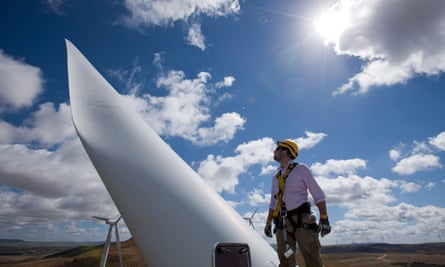Extract from The Guardian
Wind and solar displacing coal in the five states of the national energy market

Last modified on Thu 5 Nov 2020 03.32 AEDT
Wind and solar power pushing out fossil fuel generation has cut Australia’s greenhouse gas emissions more than the Covid-19 pandemic, according to a new analysis.
Renewable energy’s share of electricity generation also hit a record 26.5% across the five states forming the national energy market in the 12 months to the end of September.
Analysis by Hugh Saddler, an energy consultant and Australian National University honorary associate professor, shows continued growth in renewable energy generation, with the trend set to continue as more wind and solar power comes online.
Emissions from electricity generation, gas use and transport in the 12 months ending in July 2020 fell by almost 14 million metric tonnes of carbon dioxide equivalents – a drop of 4.6% on the previous 12 months, the analysis shows.
The data used in the analysis, produced for the progressive thinktank the Australia Institute, includes electricity generation in the national market, as well as consumption of gas and petroleum fuels.
Queensland, New South Wales, the Australian Capital Territory, Victoria, South Australia and Tasmania make up the national electricity market that supplies about 9 million customers.
But while fewer plane flights meant a sharp fall in aviation fuel use, a larger share of the overall fall in emissions was taken up by wind and solar power displacing coal in the national energy market.
The pandemic had not delivered a clear change in the use of electricity, the analysis said, but renewables were taking an ever larger share.
The record share for renewables also meant a record low share for fossil fuel generation. Electricity from burning black coal also reached a record low of 40.5% of generation across the national market.
For the first time, Saddler says black coal’s contribution to electricity generation had dropped below 50% for four months in a row.
Renewable energy’s share of the demand for electricity continues to break records. During the middle of the day on 10 October, renewable generation, including rooftop solar, reached a record-high maximum of 53.6% of total demand for electricity.
August and September are generally good months for renewable energy, with days getting longer, the sun getting higher in the sky and windy spring days all happening when demand is also generally low.
Saddler’s analysis predicts that renewables’ share of electricity generation will continue to break records in October and November.
Richie Merzian, the Australia Institute’s climate and energy program director, told Guardian Australia: “Renewables in Australia are now cheaper and more popular than fossil fuels, and we expect a lot more renewables coming on line soon.”
He said the fact that renewables were helping to lower emissions more than the economic slowdown showed that renewables “can have far more of an impact than pandemics or technology roadmaps” to Australia’s greenhouse gas emissions.
“This is just the start,” he said. “But to really nail Australia’s emissions, you need to electrify everything with renewables.”
No comments:
Post a Comment